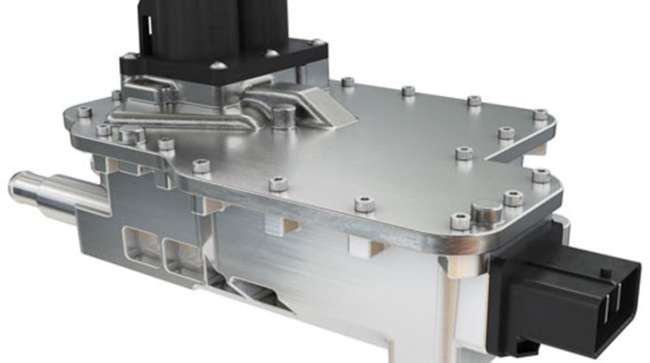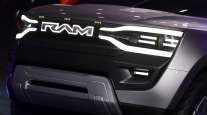Senior Reporter
Eaton Develops 48-Volt Systems to Cut Emissions, Raise Fuel Efficiency

[Stay on top of transportation news: Get TTNews in your inbox.]
Power management company Eaton Corp. announced a series of 48-volt technologies to assist its global on- and off-highway commercial vehicle customers transitioning from traditional 12- and 24-volt vehicle systems to improve fuel efficiency and reduce emissions.
“Of the options available, 48-volt architectures are becoming more popular because they can decrease both CO2 [carbon dioxide] and NOx [oxides of nitrogen] simultaneously,” said Ben Karrer, Eaton Vehicle Group’s technology development manager .
The Environmental Protection Agency recently announced plans to reduce GHG emissions and other harmful air pollutants from heavy-duty trucks. EPA said it is working on a series of major rulemakings over the next three years.

Karrer
Collectively, the new emission regulations will reduce tailpipe NOx limits by up to 90%, accelerating the need for global engine manufacturers to employ additional emission-reduction strategies, according to Eaton’s Galesburg, Mich.-based vehicle group.
The first EPA rulemaking, to be finalized in 2022, will apply to heavy-duty vehicles starting in model year 2027. That action will set new standards for criteria pollutants for the entire sector as well as targeted upgrades to the current “Phase 2” GHG emissions standards for that model year.
Meanwhile, Eaton is developing 48-volt electric catalyst heating, which provides heat directly to the vehicle’s aftertreatment system. This active heating helps catalyst components reach efficient operating temperatures faster upon engine start and maintain those temperatures during low-load operation — which it noted will be an essential strategy for reducing emissions to the levels required by future regulations.
EPA said it intends to focus on reducing low-load NOx emissions as it develops a new NOx regulation.
A second EPA rule would set more robust GHG emission standards for new heavy-duty vehicles sold as soon as model year 2030 and beyond.

Roeth
“I think 48-volt systems are going to be part of keeping diesel alive with lower NOx levels,” North American Council for Freight Efficiency Executive Director Mike Roeth told Transport Topics.
He said grouping “three or four or five” advantages a 48 system enables will be needed to justify an industrywide change.
“So I think we are getting to the point where all that might make sense,” Roeth said.
Forty-eight-volt power also will be used to power systems such as HVAC and the engine cooling fan, which traditionally are run by the engine, Karrer said.
“Today’s systems are not intelligent,” he said. “You can’t control when they’re on or off or adjust the levels. Converting those components to electric alternatives allows you to intelligently control them and eliminate mechanical loads.”
Eaton Company -Sustainability-report 2020 by Transport Topics on Scribd
At the same time, Eaton Vehicle Group is developing a wide range of 48-volt energy storage solutions, including lead-acid batteries and supercapacitors.
“We’re integrating various energy storage technologies into a larger storage pack including controls, fusing and contactors,” Karrer said. “Eaton’s Electrical Components Group is our partner for supercapacitors, and we will be working with most commercial-vehicle battery manufacturers for lead-acid batteries.”
Supercapacitors are able to quickly charge and discharge at higher rates than lithium-ion batteries, according to Eaton. While the size and weight are comparable to lithium-ion packs, supercapacitors don’t retain high levels of energy in comparison or require a liquid cooling system, and they have a longer life cycle.
Eaton describes itself as transforming into an intelligent power management company as it faces the shift toward electrification, energy transition and digitalization — trends that have allowed the company to grow at a much faster rate than it has historically.

Arnold
“And every day, we get confirmation that we’re on the right path,” Chairman and CEO Craig Arnold said during the latest earnings call. “We’re seeing it in the growing importance of sustainability initiatives in society. We’re seeing it in government spending. And we’re certainly seeing it in our opportunities and in our win.
“The content opportunity for Eaton in an eMobility application is a huge multiple of what we saw in our legacy business.”
EMobility is a new business within Eaton that combines elements of its electrical and vehicle businesses to deliver electric vehicle solutions to passenger car, commercial vehicle and off-highway vehicle manufacturers.
The eMobility segment posted revenue of $88 million in the second quarter compared with $56 million a year earlier. Increased research and development costs and manufacturing startup costs associated with new electric vehicle programs, partially offset by higher sales volumes, kept the operating margin and operating profit in negative territory, the company noted.
In all, Eaton had second-quarter net income of $506 million, or $1.26 per diluted share, compared with $54 million, 13 cents, a year earlier.
The Dublin-based company saw revenue in the period climb to $5.2 billion compared with $3.8 billion in the 2020 period.
Want more news? Listen to today's daily briefing below or go here for more info:




